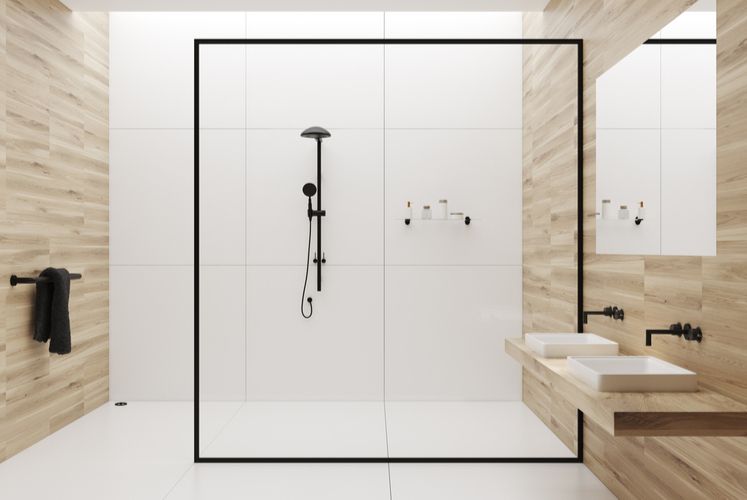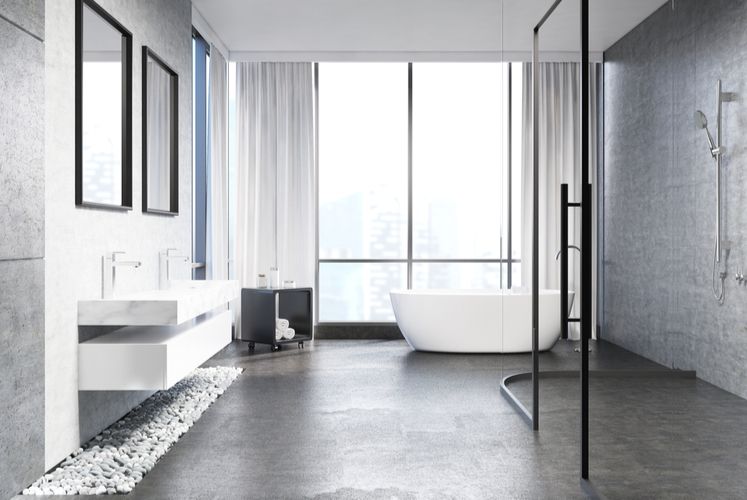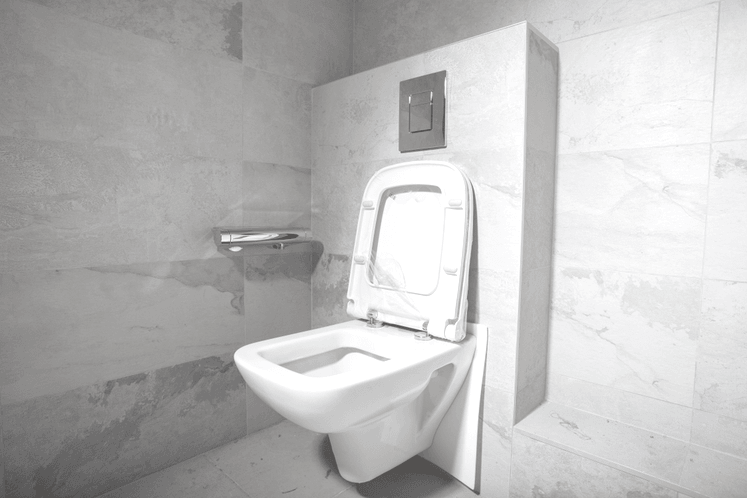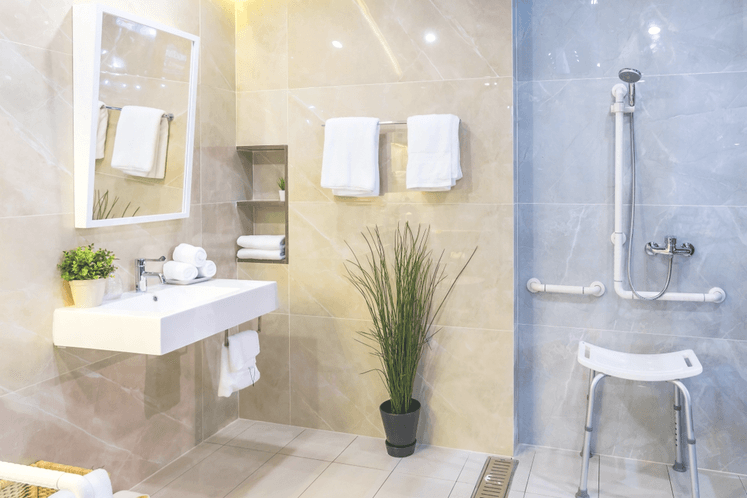Accessible bathroom designs aim to promote ease and independence for the user. Whether your bathroom will be for wheelchair users or the elderly, this guide will help you choose the best accessible features. Yet, one does not need to sacrifice style. In fact, our disabled bathroom layouts resonate luxury.
Coming up with a disabled bathroom plan
If you are designing an accessible bathroom for yourself, it is more straightforward. However, features can easily be missed. The first step is to carry out your daily routine and take notes. Consider what would make the process smoother.
Designing an accessible bathroom layout for a friend or family member doesn’t have to be strenuous either. Have the wheelchair user or older person go through their bathroom routine and share their notes with you. Alternatively, take the notes yourself if you are a carer for an elderly individual.
Compare our checklist with your daily routine to ensure every detail is accommodated in your accessible bathroom design.

Photo Credit: ImageFlow / Shutterstock
Nine things to consider for an accessible shower design:
1) Easy access
The most essential element of an accessible shower design is accessibility. Many individuals require a step-free shower. In this case, the point of entry can be zero-threshold by installing a wetroom. Even if a step-free entrance isn’t essential, the wetroom looks sleek and incorporates ease of access. Otherwise, level shower trays usually do the trick.
2) Enclosure
Ensure your shower door is outward facing or includes a sliding door for efficient and accessible shower design. A door that folds inwards may restrict the space and be inconvenient for wheelchair users. Another option is to choose a shower curtain. The final choice is a hybrid between the two, ideal for individuals with carers. Merely install glass for the base with curtains overhead.
3) Shower grips
Well placed support bars can be a useful mobility aid. The location of installation should vary on a personal basis. Examine the notes from your daily routine to see where these support bars are best fitted. Once you have found the best position, the hight, length and angle must be determined.
4) Shower seat
A shower seat is often an advantageous feature within accessible bathroom designs. These seats can be useful for all individuals with mobility difficulties. We highly recommend choosing a mounted shower seat that can be folded when unused. Alternatively, shower chairs with wheels work wonders in wetrooms.
5) Handheld shower
Fixed shower heads can be problematic for individuals with limited mobility. Instead, install a handheld shower which can double up as an overhead shower. This option provides further flexibility for the user or carer. Assure the shower head is in reach of the shower seat, should you choose to add one.
6) Temperature controls
Incorporate a remote control for inside and outside the shower to mitigate the water’s temperature. This feature is particularly useful when preparing a shower and is a winner for every accessible shower design. Rather than continually entering and exiting the premises, the water is managed remotely.
7) Space
Calculate the dimensions of the user’s mobility aids, such as a walker or wheelchair. Design the shower to allow sufficient space for these aids and add additional room in case the user changes equipment in the future. If you do not have much space to work with, a wet room that incorporates a toilet seat and sink may be your best bet.

Photo Credit: ImageFlow / Shutterstock
We also suggest forming a second calculation once all other components have been added to your shower design for the disabled or elderly. For instance, you can include dimensions of your shower storage and support rails for a perfect floor plan.
8) Wall mounted storage (for shampoo, conditioner etc.)
Mount all storage shelves at an appropriate height for easy access. Equally, ensure the fixture is secure to avoid heavy items falling. Adding a shampoo, conditioner and body wash dispenser can eliminate challenges. However, this will come down to the design of the dispenser and if it can be refilled effortlessly.
9) Slip-resistant
There are several ways to create a slip-resistant shower for those with limited mobility. For instance, you could choose tiles which are not prone to sliding. Alternatively, find a slip-resistant accessory such as adhesive bath strips or a shower matt. Check the height of a matt before ordering, mainly if you will be using a shower chair with wheels. Otherwise, treatments can be applied to the shower trays before purchase.
Accessible bathroom designs for your bathtub
1. Easy entry with low-level threshold and toughened safety glass door
2. Magnetic handset that ‘sticks’ to shower rail – simpler for hands that cannot grip so well
3. Moveable headrest for ultimate comfort and relaxation
4. Full width fold-down seat
5. Luxurious waterfall bath filler
6. Secure, easy to use latch – opens and closes with one easy movement
The best accessible bathtubs have a low-level threshold, allowing the user to enter and exit effortlessly. Walk-in baths are designed to encapsulate all the water once closed. These accessible bathroom designs are great for individuals with mobility difficulties.
Of course, you could also choose to use a standard bath. It is advisable to check the bath’s dimensions and weight restrictions to guarantee the bath would be suitable for accessibility equipment, such as hoists, lifts, or chairs. Whichever style of bath you choose, incorporating grip bars and a slip-proof base will add security.
Toilets, flushes, bidets and sanitaryware

Photo Credit: lucky boy studio / Shutterstock
Wheelchair-friendly toilet and flush solutions
If the bathroom is being designed for a wheelchair user, the toilet should be raised on-level with the chair. There is a vast range of wall mounted toilets that can be adjusted to meet your needs. A grip bar enables smooth transitions from one seat to the other. The palm operated flush should be to the side of the chair, allowing the individual to flush while seated. Alternatively, a sensor flush is appropriate.
Toilets and flushes for elderly individuals
Toilets for accessible bathroom designs for the elderly should focus on comfort rather than height. The flush can be incorporated into the wall. Yet, the system should not require excessive pressure. For that reason, elderly individuals can also benefit from palm operated or sensor flush features.
Bidets
People who struggle with mobility may find that a bidet simplifies the lavatory process. The bidet could be a separate feature which is mounted on the wall or left freestanding. Alternatively, the bidet can be consolidated into the seat.
Sanitaryware
As with the bath or shower, supporting bars are essential for every bathroom design for those with limited mobility. These aids can also be bought as sanitaryware packs specifically designed to improve the transition on and off the toilet, as well as the sink area.
Basins

Photo Credit: NavinTar / Shutterstock
Wall mounted basins are ideal for all users but particularly in a bathroom for a disabled person. The sink can be positioned in accordance with a chair or other mobility aids. Most significantly, the wall mounted sinks do not obstruct a wheelchair with an unnecessary stand. Basins with supporting handles can be useful, although regular handrails do the job just fine. Also, consider space for soap and easy access to hand-towels.
Feature Image Credit: Travelerpix / Shutterstock
